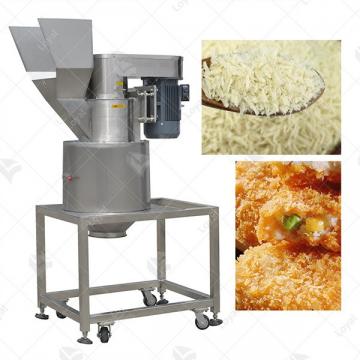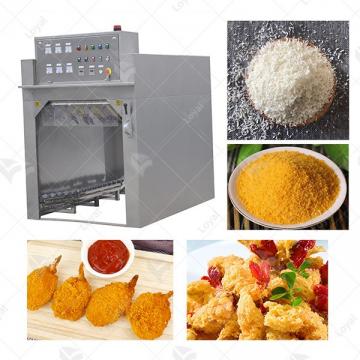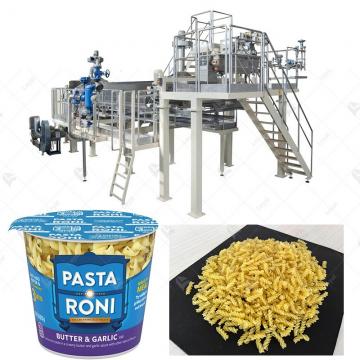
- Shandong Loyal Industrial Co.,Ltd.
- Industrial Microwave Oven Food Extruder Machine Biscuit Making Machine
Home> Company News> Everything you Need to Know About Baking Machine Panko Bread Crumb Production

Everything you Need to Know About Baking Machine Panko Bread Crumb Production
2024-06-25 09:45:05Introduction to Baking Machine Panko Bread Crumb Production
Baking machines play a crucial role in the industrial production of Panko bread crumbs. These machines are specialized equipment designed to handle large-scale production requirements efficiently. They automate the baking process, ensuring consistency and quality in every batch of Panko bread crumbs produced.
Baking machines used in Panko bread crumb production are equipped with advanced technologies tailored to meet the specific needs of the baking industry. They incorporate features such as precise temperature control, automated mixing and kneading mechanisms, and conveyor systems that streamline the baking process from start to finish.
The production of Panko bread crumbs involves several stages, beginning with the preparation of the dough, which is then processed through the baking machine. These machines ensure uniformity in texture and size of the bread crumbs by regulating baking time and temperature. This precision is essential to achieve the desired light and airy texture characteristic of Panko bread crumbs.
In addition to their functional aspects, modern baking machines are designed with hygiene and safety standards in mind. They are constructed using materials that are easy to clean and maintain, minimizing the risk of contamination during production. This ensures that the Panko bread crumbs produced are not only delicious but also safe for consumption.
Baking machines are integral to the efficient and high-quality production of Panko bread crumbs. They embody innovation and reliability, catering to the demanding needs of the food processing industry while maintaining the distinct texture and flavor that consumers expect from this versatile ingredient.

History and Evolution of Panko Bread Crumbs
Panko bread crumbs have a fascinating history that traces back to their origins in Japan. Introduced in the late 19th century, panko crumbs revolutionized the culinary world with their unique texture and versatility. Initially used in Japanese cuisine for dishes like tonkatsu and tempura, panko quickly gained popularity for its light and crispy texture, distinct from traditional bread crumbs. This innovation stemmed from Japan's aim to create a lighter alternative to the denser bread crumbs used in European cooking at the time.
Over time, panko bread crumbs evolved to meet the demands of both Japanese and international markets. The production methods gradually refined to enhance the texture and shelf life of panko crumbs, making them suitable for various cooking applications beyond Japanese cuisine. Industrial advancements in baking machines played a crucial role in scaling up production while maintaining the high quality and consistency expected from panko crumbs in commercial settings.
In recent decades, the global demand for panko bread crumbs has surged, driven by the growing popularity of crispy coatings in diverse culinary traditions worldwide. This evolution underscores the adaptability of panko crumbs in contemporary cooking practices, where they are used not only for traditional frying but also as toppings for casseroles, salads, and even desserts. Modern baking machines have further streamlined the manufacturing process, ensuring that panko crumbs meet rigorous standards of texture, flavor, and nutritional content required by today's discerning consumers.
The history and evolution of panko bread crumbs reflect a journey of innovation and adaptation in response to changing culinary preferences and technological advancements. From its humble beginnings in Japanese cuisine to its widespread use in global kitchens today, panko crumbs continue to be a staple ingredient supported by efficient baking machines that uphold their quality and consistency across diverse food applications.

Importance of Quality in Bread Crumb Production
Quality plays a pivotal role in bread crumb production, especially within industrial settings where consistency and reliability are paramount. Achieving high-quality bread crumbs involves precise control over various factors throughout the production process, ensuring that the end product meets industry standards and consumer expectations.
Firstly, the quality of bread crumbs directly impacts the final product's texture, appearance, and functionality in culinary applications. Baking machines designed for bread crumb production must maintain consistent performance to achieve uniform size and texture, crucial for applications such as breading or topping in food products. This consistency enhances product appeal and ensures that end-users receive a reliable ingredient for their recipes, whether in commercial kitchens or food manufacturing facilities.
Secondly, ensuring high-quality bread crumbs is essential for meeting regulatory standards and certifications. Industrial food equipment, including baking machines, must adhere to strict hygiene and safety guidelines to prevent contamination and ensure food safety. By maintaining quality control measures throughout production, manufacturers can confidently comply with regulatory requirements, safeguarding both consumer health and the reputation of their brands in the market.
Thirdly, quality assurance in bread crumb production contributes significantly to operational efficiency and cost-effectiveness. Efficient use of baking machines not only reduces waste but also optimizes resource utilization, such as ingredients and energy. Consistent quality minimizes the need for rework or product recalls, thereby lowering production costs and enhancing overall profitability for food manufacturers.
Lastly, in the competitive food industry landscape, the quality of bread crumbs can differentiate a product in terms of taste, texture, and performance. Consumers increasingly prioritize high-quality ingredients in their food choices, influencing purchasing decisions. Therefore, maintaining superior quality in bread crumb production not only meets market demands but also fosters customer loyalty and brand reputation over time.
The importance of quality in bread crumb production cannot be overstated. It encompasses consistency, compliance with regulations, operational efficiency, and market competitiveness. Baking machines designed for this purpose must uphold stringent quality standards to deliver reliable, safe, and appealing bread crumbs that meet the diverse needs of food manufacturers and consumers alike.

Types of Baking Machines Used
|
Type of Baking Machine |
Description |
|
Continuous Oven |
Long, conveyor-belt style oven ideal for consistent baking at high volumes. |
|
Rotary Rack Oven |
Rotates trays of dough or bread for even baking, suitable for large batches. |
|
Deck Oven |
Multi-level oven with stone or metal decks for artisan-style baking. |
|
Spiral Mixer |
Used for mixing large batches of dough consistently and efficiently. |
|
Dough Divider and Rounder |
Divides dough into equal portions and rounds them for uniformity. |
|
Proofer |
Provides controlled environment for dough to rise before baking. |
|
Bread Slicer |
Automatically slices baked bread into uniform slices. |
|
Dough Sheeter |
Sheets dough to desired thickness for consistent baking results. |
|
Baguette Moulder |
Shapes dough into baguette forms before baking. |
|
Bread Crumb Grinder |
Grinds bread into crumbs, essential for Panko bread crumb production. |

Production Process of Panko Bread Crumbs
The production process of Panko bread crumbs involves several critical steps, leveraging advanced baking machines tailored for industrial-scale operations. These machines play a pivotal role in ensuring consistency and efficiency throughout the production line.
To begin with, the process starts with the preparation of the bread mixture. High-quality bread, often with specific moisture content, is selected and fed into the baking machine. This machine, equipped with precise mixing and kneading mechanisms, ensures uniformity in the dough consistency, a crucial factor in producing high-grade Panko bread crumbs.
Once the dough is ready, it undergoes a baking phase within the machine. The baking machine utilizes controlled temperatures and baking times to achieve the desired texture and color of the bread. This step is essential as it directly impacts the final characteristics of the bread crumbs, including their crispiness and absorbency.
Following the baking phase, the bread undergoes a cooling process. Industrial baking machines incorporate cooling mechanisms to efficiently lower the temperature of the baked bread. This cooling step is critical as it prepares the bread for the subsequent slicing and shredding processes without compromising its structure or texture.
After cooling, the bread is precisely sliced into uniform pieces within the baking machine. Modern slicing technologies integrated into these machines ensure consistency in slice thickness, which is crucial for achieving uniformity in the final Panko bread crumbs.
Once sliced, the bread pieces are further processed into crumbs. This shredding process is a key feature of baking machines designed for Panko bread crumb production. The machines shred the bread slices into coarse or fine crumbs, depending on the specific requirements of the end product. This step is meticulously controlled to produce crumbs of consistent size and texture, meeting industry standards and consumer expectations.
The production process of Panko bread crumbs heavily relies on advanced baking machines optimized for each stage—from dough preparation to final shredding. These machines not only ensure efficiency and consistency but also contribute to maintaining the high quality and versatility of Panko bread crumbs used across various culinary applications.

Market Trends and Demand for Panko Bread Crumbs
In recent years, the market for Panko bread crumbs has experienced notable growth, driven by evolving consumer preferences and culinary trends. Baking machine technology plays a pivotal role in meeting this demand efficiently.
The increasing popularity of international cuisines, particularly Japanese and Asian fusion dishes, has significantly boosted the demand for Panko bread crumbs worldwide. These bread crumbs are renowned for their light, crispy texture, making them a preferred choice in various recipes, including coatings for fried foods and toppings for casseroles and baked dishes.
Moreover, the shift towards healthier eating habits has influenced the market dynamics of Panko bread crumbs. Consumers are increasingly seeking products that offer texture and flavor without compromising on quality. Baking machines equipped with advanced technology ensure consistent production of high-quality Panko bread crumbs that meet these consumer expectations.
Additionally, the foodservice industry's expanding footprint, including restaurants, cafes, and fast-food chains, has contributed to the growing demand for Panko bread crumbs. These establishments often rely on efficient baking machines to maintain a steady supply of crispy and uniform bread crumbs for their culinary offerings. As a result, manufacturers are continually innovating their baking machine designs to enhance productivity and meet the increasing demands of the market.
The market for Panko bread crumbs is poised for continued growth, driven by evolving consumer preferences towards crispy textures and international flavors. Baking machine technology remains integral to meeting this demand efficiently, ensuring that manufacturers can deliver high-quality products that cater to the diverse needs of the food industry.

Environmental Impact and Sustainability in Production
Environmental sustainability is a critical consideration in the production of baking machine panko bread crumbs. The industrial processes involved can have significant implications for the environment, making sustainable practices essential to mitigate adverse effects.
Firstly, the use of baking machines in panko bread crumb production involves energy consumption on a large scale. These machines operate continuously to achieve high production volumes, requiring substantial electricity usage. Therefore, manufacturers are increasingly investing in energy-efficient baking machines equipped with advanced technologies to minimize energy consumption during production.
Secondly, the sourcing of raw materials for panko bread crumbs, such as wheat flour and yeast, directly impacts agricultural practices and biodiversity. Sustainable sourcing practices involve partnering with suppliers who adhere to responsible farming techniques, including soil conservation and minimal pesticide usage. This ensures that the environmental footprint of raw material production is minimized.
Thirdly, waste management is another crucial aspect of sustainability in panko bread crumb production. The manufacturing process generates waste materials such as unused dough trimmings and packaging waste. To address this, industrial facilities implement comprehensive waste reduction strategies, including recycling initiatives and the adoption of biodegradable packaging materials. By minimizing waste sent to landfills, manufacturers contribute to a more sustainable production cycle.
Lastly, water usage in baking machine operations is carefully monitored to reduce environmental impact. Large-scale production facilities implement water-saving technologies and practices, such as recycling water used in cooling systems and optimizing cleaning processes. These measures not only conserve water resources but also reduce the discharge of wastewater into the environment, thereby supporting water conservation efforts.
In conclusion, environmental impact and sustainability are integral considerations in the production of baking machine panko bread crumbs. Through the adoption of energy-efficient technologies, sustainable sourcing practices, effective waste management, and responsible water usage, manufacturers can minimize their environmental footprint while meeting the growing demand for this versatile breadcrumb product. These efforts not only benefit the environment but also enhance the overall sustainability of industrial food production processes.
References
1.Food Engineering Magazine - https://www.foodengineeringmag.com/
2.Food Processing - https://www.foodprocessing.com/
3.Packaging World - https://www.packworld.com/
4.Food Manufacturing - https://www.foodmanufacturing.com/
5.Processing Magazine - https://www.processingmagazine.com/
 Japanese panko bread crumbs making machine
Japanese panko bread crumbs making machine Japanese Bread Crumbs Processing Line
Japanese Bread Crumbs Processing Line Commercial Japanese Panko Bread Crumb Grinder Machine
Commercial Japanese Panko Bread Crumb Grinder Machine Instant Pasta Production Line
Instant Pasta Production Line